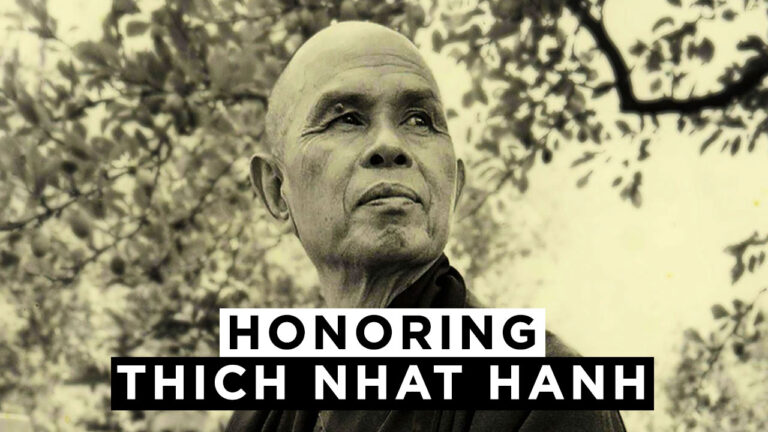author philosopher teacher
Honoring Thich Nhat Hanh: The Buddha of the Modern World

I knew this day was coming, but I never wanted it to come. For the sheer selfish reason that a world with Thich Nhat Hanh in it is a lot better than one without him in it. In 2014, when I heard the news of his brain hemorrhage, I was deeply saddened and I couldn’t digest the thought of his eventual passing at that time. But when I heard the news of Thich Nhat Hanh’s passing, I was sad, but then my sadness quickly transformed into joy. My joy stemmed from having the opportunity to live in a world where a Buddha like Thay (an affectionate name for Thich Nhat Hanh, meaning master) lived and for what he has left behind for humanity.
When the great Advaita Vedanta sage of the 20th century, Bhagavan Sri Ramana Maharshi was dying, one disciple was grief stricken with the idea of his passing. But Bhagavan said, “Where can I go?” This sentiment is the crux of nondual philosophy. There is no birth or death, but instead, as Thay taught, birth and death are just a revolving doorway of beginning-less time. Just like Bhagavan, considering Advaita Vedanta and Zen Buddhism are both nondual philosophies, Thay addressed his inevitable death in his book At Home in the World:
This body of mine will disintegrate, but my actions will continue me… If you think I am only this body, then you have not truly seen me. When you look at my friends, you see my continuation. When you see someone walking with mindfulness and compassion, you know he is my continuation. I don’t see why we have to say “I will die,” because I can already see myself in you, in other people, and in future generations.
Even when the cloud is not there, it continues as snow or rain. It is impossible for the cloud to die. It can become rain or ice, but it cannot become nothing. The cloud does not need to have a soul in order to continue. There’s no beginning and no end. I will never die. There will be a dissolution of this body, but that does not mean my death.
I will continue, always.
This nondual knowledge of the intrinsic oneness of the world Thay lived by until his last breath. Zen Buddhism is built on such knowledge and this informed Nhat Hanh’s steadfast practice of mindfulness, inspiring millions around the world to engage themselves in meditation. What could be more important than meditation in a world that constantly divides itself into artificial camps of opposition? With his help, the hypnosis of separation was revealed as nothing more than a dream to those who actively engage in mindfulness and remain in the ever-present eternal moment that is the heart of Zen. However, Zen is much more than mindfulness and remaining in the here and now.
Thay was a prolific author, writing more than 100 books, which have been translated into 35 languages. As an author myself, I know writing over 100 books is something not many individuals could achieve. This was the unspoken genius of Nhat Hanh. The teachings of Zen just flowed through him, bringing more peace to the world with every word written. His books range from simple teachings on mindfulness to scholarly works on Zen practice and the deeper wisdom of the tradition. One of my personal favorites is a lesser-known book called Silence. This book helped my own practice and reinforced the importance of silence in a world full of noise. Thay really taught me the art of peace in a world completely distracted from the nature of reality.
Many of us find ourselves in the same predicament as Shakespeare’s Hamlet; we live in a world devoid of moral values but we still have personal integrity, and it is up to us to never lose those principles. Thay is the perfect embodiment of Hamlet. All that he had to deal with in his life, from being exiled by his home country of Vietnam to the ongoing injustice that plagues the soul of humanity, Thay remained peaceful with a smile on his face. The confused and often violent world did not infect his soul. He continued to be a beacon of light in a world that easily succumbs to darkness. The great news is he will remain a beacon of light for humanity, even though his body has died.
A core teaching shared by all schools of Buddhism is Pratītyasamutpāda, commonly translated as dependent origination or dependent arising. Pratītyasamutpāda is the understanding that nothing spontaneously exists all on its own. Everything in the phenomenal world, including both physical and mental, has many contributing factors and conditions of causation. The basic principle, then, is that all things arise in dependence upon other things, which is an interdependent co-arising or inter-being, a term coined by Thich Nhat Hanh. This should bring great warmth to our hearts because in the interconnectivity of life, we all live on through the hearts and minds of those we leave behind. Though, in reality, we haven’t really gone anywhere; only the body has returned to the Earth. The soul continues on and is woven into the fabric of life.
Thay, then, is still here. His body died, but his presence remains. You can feel it in the movement of the clouds, the falling leaves on a beautiful autumn day, a smiling face, and so on. I can feel his presence here. Can you? This is why my sadness quickly turned to joy and I could never have had that realization or understanding without the life and teachings of Thich Nhat Hanh.
I remember when Thay was explaining his love for Buddhism. It is not a complex story, but rather a very simple one. He was walking one day and saw an image of the Buddha, his face so serene and joyful. Thay had never seen a face like that; no one he knew exhibited this calmness. With that one encounter with the Buddha, his life was set on its natural course. Peace can flower in our hearts in many ways; it only took that one look from the Buddha to move Thay.
Laying his eyes on the Buddha only once transformed Thich Nhat Hanh, transforming him into a modern day Buddhaghosa, meaning “voice of the Buddha.” But being the voice of the Buddha is not enough when referring to Thay, he was a real living Buddha, and our world will forever be a better place for gracing our lives with his love. But this is not a goodbye, rather, it is an acknowledgment that you are still here in our hearts, inspiring humanity towards the peace and equanimity that is all of our destinies. If he could speak to us now, I’m sure he would use similar words from his book No Fear, No Death to convey his passing from the phenomenal world:
This body is not me; I am not caught in this body, I am life without boundaries, I have never been born and I have never died. Over there the wide ocean and the sky with many galaxies all manifests from the basis of consciousness. Since beginning less time I have always been free. Birth and death are only a door through which we go in and out. Birth and death are only a game of hide-and-seek. So smile to me and take my hand and wave good-bye. Tomorrow we shall meet again or even before. We shall always be meeting again at the true source. Always meeting again on the myriad paths of life.
NOTE: This site directs people to Amazon and is an Amazon Associate member. As an Amazon Associate I earn from qualifying purchases, at no additional cost to you. The pages on this website may contain affiliate links, which means I may receive a commission if you click a link and purchase something that I have recommended. This goes a tiny way towards defraying the costs of maintaining this site.
